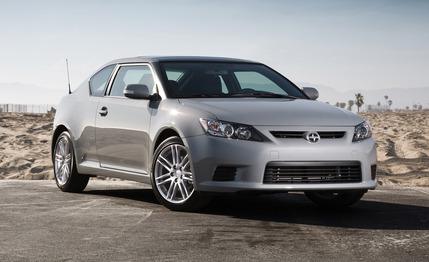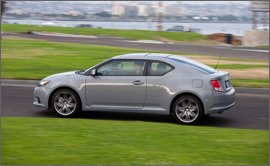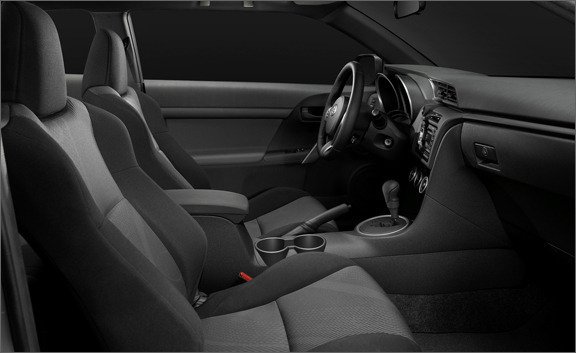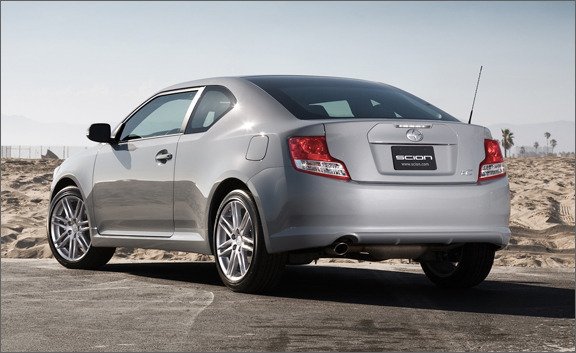
 Short Take Road Test
Short Take Road Test
When Scion hit U.S. streets in 2004, it was a quirky little brand that sprouted from its traditionalist parent company, Toyota. Today, the original Scion oddballs—the first-gen xB and xA—are gone, having been replaced by larger, heavier, costlier, and more, well, Toyota-like models. (The xB is in its second generation, and the xD has assumed the xA’s place in the lineup.) Maturity seemingly trumped originality in the Scion showroom, and sales plummeted. The brand may have learned a lesson, though, because the redesigned 2011 Scion tC doesn’t stray from the original’s successful script.
It’s New—Really!
You’re forgiven if the newness of the 2011 tC eludes you. The platform changes little, and the wheelbase and overall length remain the same, at 106.3 and 174.0 inches. Width, however, is up by 1.6 inches, and the track increases by 1.3 inches at the front and 2.1 inches at the rear. Weight is up by 144 pounds to 3160. And although it looks a lot like the previous tC, the new car actually shares no exterior panels with its predecessor. The major changes lie beneath the surface.


A new 2.5-liter four-cylinder engine with 180 hp replaces the 161-hp, 2.4-liter four. Despite the extra power, fuel economy improves slightly, thanks to a new six-speed manual that replaces a five-speed unit and a six-speed automatic that has two more forward ratios than its predecessor had. Fuel mileage jumps from 20 mpg city and 27 mpg highway for the manual and 21/29 for the automatic to 23/31 for the new car, regardless of transmission. The new engine boasts 11 additional lb-ft of torque for a total of 173. More torque had us expecting easier low-end acceleration, but we instead found ourselves revving toward the 6250-rpm redline to find meaningful thrust. Work the new engine hard, and it sounds a bit strained; although the exhaust barks out a nicely tuned, warm rasp to people outside the car, none of that aural goodness makes it to the pilot, who simply hears a constant buzziness. We recommend driving with the window down to experience what bystanders get to hear. (Click here to hear the 2011 Scion tC.)
Roomier Interior, Super Seats
Put aside the engine noise, and the interior becomes the best part of the tC. The dashboard plastics are hard, but there’s otherwise little evidence of scrimping. The comfortable, grippy, and supportive seats had us looking for a Recaro label. The thick-rimmed steering wheel had us thinking Lexus LF-A. And the 300-watt, eight-speaker sound system had us thinking Mark Levinson. Compared with the spacecraft-inspired dashboards of the Honda CR-Z or Civic, the tC’s looks a bit stark, but the simple design is clean, driver-oriented, and free of overly designed nonsense. And although the overall length remains the same as the 2010 car's, the new model’s extra width translates to a marginally roomier interior that has 1.1 more inches of front shoulder room and more leg, shoulder, and hip room (1.0 inch, 2.1 inches, and 1.2 inches, respectively) in the rear.
As on the first-gen model, a MacPherson-strut front suspension and a multilink rear suspension are used on this second generation. A firm ride is part of the tC experience, and although this Scion is a supremely easy car to drive quickly, it seems too demure to engage in the sort of fleet-footed playfulness that makes the Mazda 3 so much fun. Imagine driving a Corolla with a firm suspension and larger tires, and you won’t be far off. The steering is fairly numb, although not offensively so; it’s simply that some competitors offer more connection with the road. So the tC is not as much fun, but it almost makes up for that deficit with its substantial and refined feel.


Perhaps in keeping with this Scion’s mature attitude, the tC can slow down in a hurry. Stopping from 70 mph took a sports-car-like 166 feet. Our testing revealed a 0-to-60-mph time of 7.4 seconds for the six-speed automatic (we haven’t yet had the opportunity to test a manual version). That exactly matches the time of a five-speed-manual tC that we tested back in August 2004. Although the acceleration is unlikely to result in a trip to the cardiac ward, neither will the as-tested price of $19,995. If you want to shift for yourself, manual-transmission versions cost $1000 less.
It’s clear that, at least as it applies to this car, radical change is out at Scion. (Look toward the upcoming Scion iQ for weirdness.) But the tC never was the radical Scion, hewing closely to a tried-and-true formula of sporty looks, decent price, and reasonable power. Scion’s brand statement might not ever contain “reasonable” or “tried and true,” but those are what the tC has been about from the beginning, and this new car continues that charge.

